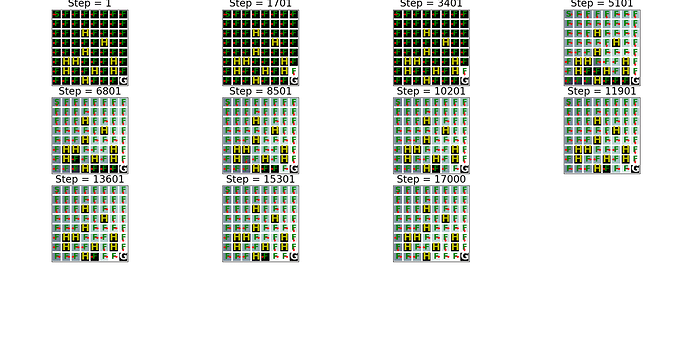https://d2l.ai/chapter_reinforcement-learning/qlearning.html
https://d2l.ai/chapter_reinforcement-learning/qlearning.html
When I click on this URL I get redirected to the homepage, does it mean it is not published yet? Is there a way I can see it anyway?
Looking forward to the DQN chapter.
Coming from the MITx’s McroMasters series on Stats and Probability a year ago, I can still understand (mostly) what’s going on.
Great work. Thank you.
For convenience, these 2 functions should make it easy to switch into 8x8. Param “size” expects either “4x4” or “8x8”. These 2 functions exist within torch: i just copied them out and adapted for my own use.
Everything else kept the same: A 4 times increase in lake area resulted in an increase of iterations (to reach something usable), from 256 to about 17000, a 66 times increase. Even then, the bottom left area is clearly not optimal.
def frozen_lake_sizeable(seed, size):
"""Defined in :numref:`sec_utils`"""
# See https://www.gymlibrary.dev/environments/toy_text/frozen_lake/ to learn more about this env
# How to process env.P.items is adpated from https://sites.google.com/view/deep-rl-bootcamp/labs
import gym
env = gym.make('FrozenLake-v1', is_slippery=False, map_name=size)
env.seed(seed)
env.action_space.np_random.seed(seed)
env.action_space.seed(seed)
env_info = {}
env_info['desc'] = env.desc # 2D array specifying what each grid item means
env_info['num_states'] = env.nS # Number of observations/states or obs/state dim
env_info['num_actions'] = env.nA # Number of actions or action dim
# Define indices for (transition probability, nextstate, reward, done) tuple
env_info['trans_prob_idx'] = 0 # Index of transition probability entry
env_info['nextstate_idx'] = 1 # Index of next state entry
env_info['reward_idx'] = 2 # Index of reward entry
env_info['done_idx'] = 3 # Index of done entry
env_info['mdp'] = {}
env_info['env'] = env
for (s, others) in env.P.items():
# others(s) = {a0: [ (p(s'|s,a0), s', reward, done),...], a1:[...], ...}
for (a, pxrds) in others.items():
# pxrds is [(p1,next1,r1,d1),(p2,next2,r2,d2),..].
# e.g. [(0.3, 0, 0, False), (0.3, 0, 0, False), (0.3, 4, 1, False)]
env_info['mdp'][(s,a)] = pxrds
return env_info
def show_Q_function_progress(env_desc, V_all, pi_all, size):
"""Defined in :numref:`sec_utils`"""
# This function visualizes how value and policy changes over time.
# V: [num_iters, num_states]
# pi: [num_iters, num_states]
from matplotlib import pyplot as plt
if size == "4x4":
side = 4
if size == "8x8":
side = 8
# We want to only shows few values
num_iters_all = V_all.shape[0]
num_iters = num_iters_all // 10
vis_indx = np.arange(0, num_iters_all, num_iters).tolist()
vis_indx.append(num_iters_all - 1)
V = np.zeros((len(vis_indx), V_all.shape[1]))
pi = np.zeros((len(vis_indx), V_all.shape[1]))
for c, i in enumerate(vis_indx):
V[c] = V_all[i]
pi[c] = pi_all[i]
num_iters = V.shape[0]
fig, ax = plt.subplots(figsize=(15, 15))
for k in range(V.shape[0]):
plt.subplot(4, 4, k + 1)
plt.imshow(V[k].reshape(side, side), cmap="bone")
ax = plt.gca()
ax.set_xticks(np.arange(0, side+1)-.5, minor=True)
ax.set_yticks(np.arange(0, side+1)-.5, minor=True)
ax.grid(which="minor", color="w", linestyle='-', linewidth=3)
ax.tick_params(which="minor", bottom=False, left=False)
ax.set_xticks([])
ax.set_yticks([])
# LEFT action: 0, DOWN action: 1
# RIGHT action: 2, UP action: 3
action2dxdy = {0:(-.25, 0),1:(0, .25),
2:(0.25, 0),3:(-.25, 0)}
for y in range(side):
for x in range(side):
action = pi[k].reshape(side, side)[y, x]
dx, dy = action2dxdy[action]
if env_desc[y,x].decode() == 'H':
ax.text(x, y, str(env_desc[y,x].decode()),
ha="center", va="center", color="y",
size=20, fontweight='bold')
elif env_desc[y,x].decode() == 'G':
ax.text(x, y, str(env_desc[y,x].decode()),
ha="center", va="center", color="w",
size=20, fontweight='bold')
else:
ax.text(x, y, str(env_desc[y,x].decode()),
ha="center", va="center", color="g",
size=15, fontweight='bold')
# No arrow for cells with G and H labels
if env_desc[y,x].decode() != 'G' and env_desc[y,x].decode() != 'H':
ax.arrow(x, y, dx, dy, color='r', head_width=0.2, head_length=0.15)
ax.set_title("Step = " + str(vis_indx[k] + 1), fontsize=20)
fig.tight_layout()
plt.show()
Thank you for the feedback and glad that you found our RL chapters useful.
Sure, DQN will be coming in a few weeks.
Yes, the number of training steps increases as state space gets larger. epsilon and alpha might need to be changed for a larger version of this problem. In general, model-free methods have very high sample complexity.
We’ll definitely make our codes more flexible so it can better visualize larger size grids. Also, thank you for your code snippet.
Rasool
Glad to know that DQN is on the way! Thanks for your contribution.
May I know what you will or plan to present in the whole RL chapter for the final version? That will be helpful since I would like to schedule or learn in advance.
there is a bug when running the following code in colab.
Now set up the environment
env_info = d2l.make_env(‘FrozenLake-v1’, seed=seed)
bug is as follow.
AttributeError: ‘FrozenLakeEnv’ object has no attribute ‘nS’
the reinforcement learning part is a bit too compact… still wish to see DQN
Excellent content! I just have slight ambiguity in the sign in eq. 17.3.3; shouldn’t alpha be preceded with + in second term of the equation? Similarly in 17.3.4.
Yes, the RL part won’t run.
First of all, I have to manually install ‘gym’, it’s not part of the environment set up for the book overall.
Secondly, even after doing that, get this error:
AttributeError Traceback (most recent call last)
Cell In[3], line 13
10 np.random.seed(seed)
12 # Now set up the environment
—> 13 env_info = d2l.make_env(‘FrozenLake-v1’, seed=seed)
File /usr/local/lib/python3.10/site-packages/d2l/torch.py:2852, in make_env(name, seed)
2848 # Input parameters:
2849 # name: specifies a gym environment.
2850 # For Value iteration, only FrozenLake-v1 is supported.
2851 if name == ‘FrozenLake-v1’:
→ 2852 return frozen_lake(seed)
2854 else:
2855 raise ValueError(“%s env is not supported in this Notebook”)
File /usr/local/lib/python3.10/site-packages/d2l/torch.py:2821, in frozen_lake(seed)
2818 import gym
2820 env = gym.make(‘FrozenLake-v1’, is_slippery=False)
→ 2821 env.seed(seed)
2822 env.action_space.np_random.seed(seed)
2823 env.action_space.seed(seed)
File /usr/local/lib/python3.10/site-packages/gym/core.py:241, in Wrapper.getattr(self, name)
239 if name.startswith(“_”):
240 raise AttributeError(f"accessing private attribute ‘{name}’ is prohibited")
→ 241 return getattr(self.env, name)
File /usr/local/lib/python3.10/site-packages/gym/core.py:241, in Wrapper.getattr(self, name)
239 if name.startswith(“_”):
240 raise AttributeError(f"accessing private attribute ‘{name}’ is prohibited")
→ 241 return getattr(self.env, name)
File /usr/local/lib/python3.10/site-packages/gym/core.py:241, in Wrapper.getattr(self, name)
239 if name.startswith(“_”):
240 raise AttributeError(f"accessing private attribute ‘{name}’ is prohibited")
→ 241 return getattr(self.env, name)
AttributeError: ‘FrozenLakeEnv’ object has no attribute ‘seed’
Equation 17.3.3 should be Q = (1-alpha) * Q + alpha * (r + gamma * Q’), right? And same for the next equation.
